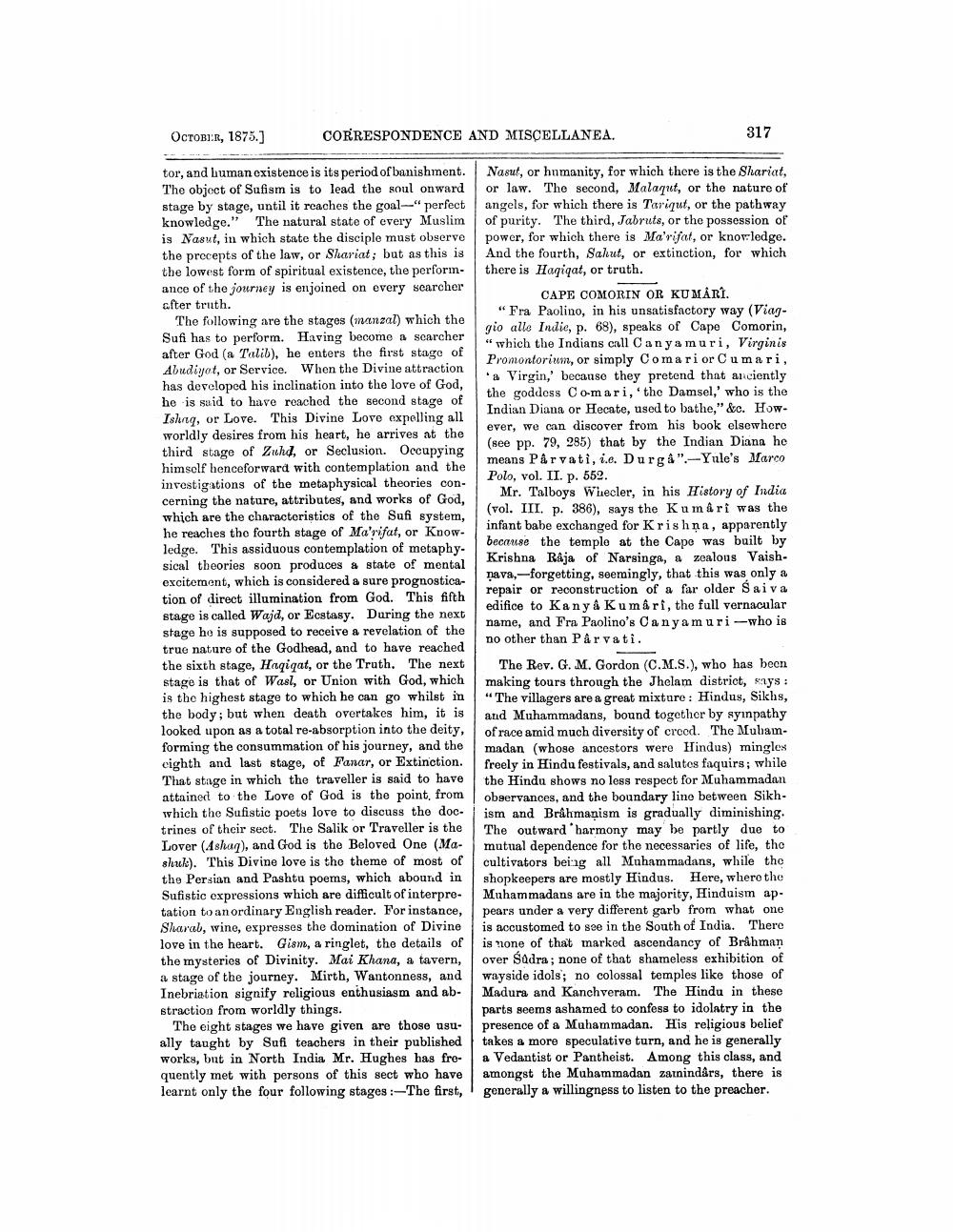________________
OCTOBI:R, 1875.]
CORRESPONDENCE AND MISCELLANEA.
317
tor, and buman existence is its period of banishment. The object of Sufism is to lead the soul onward stage by stage, until it reaches the goal "perfect knowledge." The natural state of overy Muslim is Nasut, in which state the disciple must observe the precepts of the law, or Shariat; but as this is the lowest form of spiritual existence, the perform- ance of the journey is enjoined on every searcher after truth.
The following are the stages (manzal) which the Sufi has to perform. Having become a scarcher after God (a Talib), he enters the first stage of Abudiyot, or Service. When the Divine attraction has developed his inclination into the love of God, he is suid to have reached the second stage of Ishng, or Love. This Divine Love expelling all worldly desires from his heart, he arrives at the third stage of Zuhd, or Seclusion. Occupying himself henceforward with contemplation and the investigations of the metaphysical theories concerning the nature, attributes, and works of God, which are the characteristics of the Sufi system, he reaches the fourth stage of Ma'rifat, or Knowledge. This assiduous contemplation of metaphy. sical theories soon produces & state of mental excitement, which is considered a sure prognostication of direct illumination from God. This fifth stage is called Wajd, or Ecstasy. During the next stage ho is supposed to receive a revelation of the true nature of the Godhead, and to have reached the sixth stage, Haqiqat, or the Truth. The next stage is that of Wasl, or Union with God, which is the highest stage to which he can go whilst in the body; but when death overtakes him, it is looked upon as a total re-absorption into the deity, forming the consummation of his journey, and the eighth and last stage, of Fanar, or Extinction. That stage in which the traveller is said to have attained to the Love of God is the point, from which the Sufistic poets love to discuss the doc- trines of their sect. The Salik or Traveller is the Lover (Ashag), and God is the Beloved One (Ma- shuk). This Divine love is the theme of most of the Persian and Pashtu poems, which abound in Sufistic expressions which are difficult of interpretation to an ordinary English reader. For instance, Sharal, wine, expresses the domination of Divine love in the heart. Gism, a ringlet, the details of the mysteries of Divinity. Mai Khana, a tavern, a stage of the journey. Mirth, Wantonness, and Inebriation signify religious enthusiasm and abstraction from worldly things.
The eight stages we have given are those usually taught by Sufi teachers in their published works, but in North India Mr. Hughes has froquently met with persons of this sect who have learnt only the four following stages : -The first,
Nasut, or humanity, for which there is the Shariat, or law. The second, Malaqut, or the nature of angels, for which there is Tariqut, or the pathway of purity. The third, Jabruts, or the possession of power, for which there is Ma'rifat, or knowledge. And the fourth, Sahut, or extinction, for which there is Haqiqat, or truth.
CAPE COMORIN OR KUMÅRI. "Fra Paolino, in his unsatisfactory way (Viag. gio alle Indie, p. 68), speaks of Cape Comorin, " which the Indians call Canya muri, Virginis Promontorium, or simply Comari or Cumari,
a Virgin,' because they pretend that anciently the goddess Co-mari, the Damsel,' who is the Indian Diana or Hecate, used to bathe," &c. However, we can discover from his book elsewhere (see pp. 79, 285) that by the Indian Diana he means Parvati, i.e. Durga".-Yule's Marco Polo, vol. II. p. 552.
Mr. Talboys Whecler, in his History of India (vol. III. p. 386), says the Kumari was the infant babe exchanged for Krishna, apparently because the temple at the Cape was built by Krishna Raja of Narsinga, & zealous Vaishnava,- forgetting, seemingly, that this was only a repair or reconstruction of a far older Saiva edifice to Kany & Kumari, the full vernacular name, and Fra Paolino's Can ya muri-who is no other than Pârvati.
The Rev. G. M. Gordon (C.M.S.), who has been making tours through the Jhelam district, enys: "The villagers are a great mixture: Hindus, Sikhs, and Muhammadans, bound together by syinpathy of race amid much diversity of crood. The Mubammadan (whose ancestors were Hindus) mingles freely in Hindu festivals, and salutos faquirs; while the Hindu shows no less respect for Muhammadan observances, and the boundary line between Sikhism and Brâhmanism is gradually diminishing. The outward'harmony may be partly due to mutual dependence for the necessaries of life, tho cultivators beirag all Muhammadans, while the shopkeepers are mostly Hindus. Here, where the Muhammadans are in the majority, Hinduism appears under a very different garb from what one is accustomed to see in the South of India. There is none of that marked ascendancy of Brahman over Sodra; none of that shameless exhibition of wayside idols; no colossal temples like those of Madura and Kanchveram. The Hindu in these parts seems ashamed to confess to idolatry in the presence of a Muhammadan. His religious belief takes & more speculative turn, and he is generally a Vedantist or Pantheist. Among this class, and amongst the Muhammadan zarindars, there is generally a willingness to listen to the preacher.




